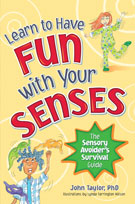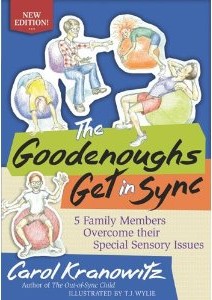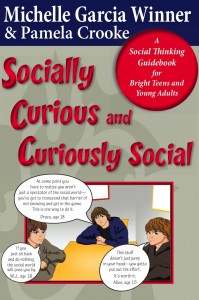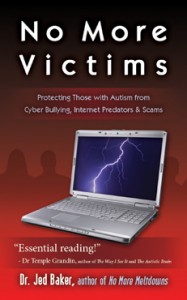
Four Books for Tweens and Teens with Sensory Processing Disorders
Being a tween or teen is not easy. Being a tween or teen with special needs is even harder. Parents and other adults who care for youth with different needs are constantly looking for resources to help these kids feel better about themselves, to feel that they are not alone with these challenges, and to help them learn strategies to cope with their special needs. This month I have chosen four books for tweens and teens to help them if they have sensory processing disorder (SPD), if they need to learn social skills, and a wonderful book about cyber bullying.1. Learn to Have Fun with Your Senses: The Sensory Avoider's Survival Guide

by John Taylor, PhD The appeal of Learn to Have Fun with Your Senses starts at first sight as your eyes are drawn to the delightful illustrations by Lynda Farrington Wilson. The choice of pastel coloured paper throughout the book, pleasing font and darker, attention grabbing green stars with call-to-action quotes will surely engage your young sensory avoider for whom this book was intended.
A six page glossary will help his comprehension, and the similarities in the format of each chapter will make each chapter easy to follow and user friendly. Your child will always learn something new in the first part of each chapter: “Did You Know?” And be motivated to action by the last part of each chapter: “Do It!”
From cover to cover this self-help guide reassures kids that their overreactions to senses is not because they are weird, lazy or stupid but because something is really wrong in how their brain handles the messages it receives from their sense organs. The encouraging part is how Dr. Taylor introduces each sense with a little quiz, to find out whether the child is overreacting to that sense. Then he follows with a list of very doable activities that promise to reduce or maybe even totally stop the overreacting!
In his message to teachers, Dr. Taylor says that a child’s number-one defence against stress is healthy self-esteem. Reading and following up on the numerous suggestions will surely put sensory avoiders on the right track to achieve this. Dr. Taylor truly achieved his purpose: “My intention is that this book will become the handiest tool you’ve ever had for working with sensory avoiders.” Read the complete review of Learn to Have Fun with Your Senses.
2. The Goodenoughs Get in Sync
5 Family Members Overcome their Special Sensory Issues by Carol Knanowitz,
This 96 page book is actually two books in one. Younger children read the large print and find an amusing account of a family that any child with sensory issues can relate to. Tweens and teens read the small print and find a wealth of information that meshes with the story about how sensory processing disorder can affect people in different ways.
by Carol Knanowitz,
This 96 page book is actually two books in one. Younger children read the large print and find an amusing account of a family that any child with sensory issues can relate to. Tweens and teens read the small print and find a wealth of information that meshes with the story about how sensory processing disorder can affect people in different ways.
The 37 pages added at the end of the story have a wealth of practical, immediately useful information for parents of children with sensory issues. Three appendices have to do with Sensory Diet Activities, how sensory processing disorder affects different individuals, and fun and functional techniques for helping kids at home and school. A list of equipment for the sensory diet and even the catalogue companies that provide the suggested equipment is included. Pages of helpful web sites end the book.
Guidance on the pronunciation of difficult words is given immediately after the word. Definitions of sensory processing disorder terms and new words are in bold type and are found in a seven page alphabetize glossary and index. This added feature makes this a handy research book to be used over and over.
I highly recommend The Goodenoughs Get in Sync ~New Edition. This book belongs in homes, at schools, public libraries, in health professional offices and surely in every hand of a child, tween, and teen with sensory processing disorder.
Carol Knanowitz is best-known for her book, The Out-of-Sync Child, which has sold more than 600,000 copies (September 2013).Over 400 sponsors have brought Carol to their communities for presentations, both in the United States and abroad — including Australia, Canada, England, India, Indonesia, Ireland, Japan, Mexico, and Singapore. Read complete review of The Goodenoughs Get in Sync
3. Socially Curious and Curiously Social
Social Thinking Guidebook for Bright Teens and Young Adults by Michelle Garcia Winner and Pamela Crooke
Teens and young adults who find it difficult to relate to others, this book is written for you! Caregivers, therapists, educators, siblings, and friends who want to understand and help someone they know navigate our complicated social interactions, read this book.
by Michelle Garcia Winner and Pamela Crooke
Teens and young adults who find it difficult to relate to others, this book is written for you! Caregivers, therapists, educators, siblings, and friends who want to understand and help someone they know navigate our complicated social interactions, read this book.
Is Socially Curious and Curiously Social for you? It is, if you:
- Can’t relate to others.
- Have difficulty asking questions or are asking too many questions.
- Can’t make small talk.
- Can’t read body language.
- Do not make or keep friends.
- Do not know how to belong to a group.
- Want to be comfortable using a phone.
- Want to learn to use Facebook, Myspace, texting, emails…
- Want to learn how to deal with bullies and jerks.
- Are clueless how your behaviour affects others.
- Don’t have social thinking smarts.
- Need life skills to apply for and keep a job, and be on your own.
4. No More Victims
Protecting Those with Autism from Cyber Bullying, Internet Predators and Scams
by Dr. Jed Baker We live in the age of easy communication! Cell phones and the internet allow users to communicate and socialize at a low cost and with an ease and scope never before seen. However we must all know how easy it is to be victimized emotionally, physically and financially in this digital world.
Cyber bullying, internet predators and scams are serious issues and hopefully by reading Dr. Baker’s 87 page booklet readers will learn of these dangers that lurk online. The book is very easy to read and most teens can read it themselves.
The book also educates parents on how to monitor Internet use and has two contracts to be signed by their children on phone and internet usage to keep them safe from cyber abuse. Individuals on the autism spectrum are signalled out as being more apt to become victims because of challenges with perspective taking, isolation and increased time online, and difficulty with assertive communication skills. However No More Victims has important advice for all individuals who rely on the digital world of cell phones and use other Internet devices.
Jed Baker, Ph.D. is the director of the Social Skills Training Project, a private organization serving individuals with autism and social communication problems. He is on the professional advisory board of Autism Today, ASPEN, ANSWER, YAI, the Kelberman Center and several other autism organizations. Read complete review of No More Victims



